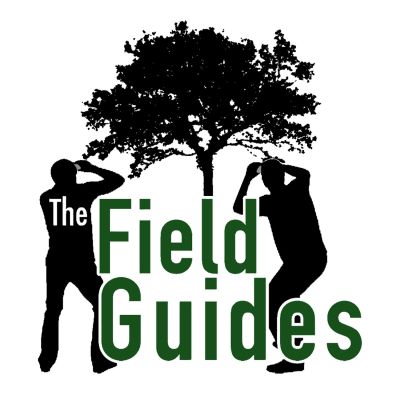Nature nerds rejoice! The Field Guides is a monthly podcast that will bring you out on the trail, focusing on the science of our North American wildlife.
http://www.thefieldguidespodcast.com/new-blog/
Bonus 02 - Bark! (feat. In Defense of Plants & Midwest Explorer)
Our 2nd bonus episode has arrived! This episode, Steve is joined by Matt from ‘In Defense of Plants’ & Sara from ‘Midwest Explorer’ for a hike at Hunter’s Creek Park. We talk about tree bark, bird poop, and American Sycamore Trees. Steve also ventures into Buffalo, NY to see the oldest American Sycamore in the world… allegedly (but probably not). Enjoy!
Useful Links and relevant time stamps:
01. In Defense of Plants:
http://www.indefenseofplants.com/
https://www.patreon.com/indefenseofplants
https://www.facebook.com/InDefenseOfPlants/
In Defense of Plants – Bark!
http://www.indefenseofplants.com/blog/2016/1/27/bark
02. Midwest Explorer:
https://www.facebook.com/themidwestexplorer/
03. Mystery Pupa [02:23]
Tomato Hornworm/ Five-spotted Hawk Moth (Manduca quinquemaculatus) [02:35]
http://bugguide.net/node/view/5011
04. Hunter’s Creek Park [02:52]
http://www.wnymba.org/static/maps/hunters.pdf
Friends of Hunter’s Creek
https://www.facebook.com/Friends-of-Hunters-Creek-128946483795779/
05. Blackberry (Rubus sp.) [03:21]
https://plants.usda.gov/core/profile?symbol=rubus
06. Multiflora Rose (Rosa multiflora) [03:51]
https://plants.usda.gov/core/profile?symbol=romu
The Field Guides – Ep. 05 - Multiflora Blows
http://www.thefieldguidespodcast.com/new-blog/2016/2/7/the-field-guides-ep-05-multiflora-rose
07. Epilobium (Willowherb) [04:02]
https://plants.usda.gov/core/profile?symbol=EPILO
08. Achene [05:02]
https://en.wikipedia.org/wiki/Achene
09. Anemochory & Myrmecochory [05:17]
https://en.wikipedia.org/wiki/Seed_dispersal_syndrome
10. Pink Etymology [05:47]
http://www.etymonline.com/index.php?term=pink
11. Betalains [06:22]
https://en.wikipedia.org/wiki/Betalain
David L. Des Marais - To betalains and back again: a tale of two pigments
http://onlinelibrary.wiley.com/store/10.1111/nph.13556/asset/nph13556.pdf;jsessionid=6FCC35B48271BFEFF143E64398B0B4D3.f04t04?v=1&t=izpvn6n1&s=1f638b188825a59732b66f9e08217d8f3bf4e2e9
The Field Guides – Ep. 12 – Pokeweed Every Day
http://www.thefieldguidespodcast.com/new-blog/2016/11/3/the-field-guides-ep-12-pokeweed-every-day
12. Foxes of North America [07:10]
http://wildliferesponse.org/index.php?option=com_content&view=article&id=54:foxes-of-north-america&catid=36:mammals&Itemid=57
13. Musclewood/American Hornbeam (Carpinus caroliniana) [07:26]
https://plants.usda.gov/core/profile?symbol=caca18
14. Ironwood/American Hophornbeam (Ostrya virginiana) [09:12]
https://plants.usda.gov/core/profile?symbol=OSVI
15. Black Cherry (Prunus serotina) [10:09]
https://plants.usda.gov/core/profile?symbol=prse2
16. Lenticels [10:56]
http://www.mhhe.com/biosci/genbio/raven6b/graphics/raven06b/other/raven06_38.pdf
Search for “lenticel”
17. Tree-ring formation [11:31]
https://www.ncbi.nlm.nih.gov/pmc/articles/PMC4880555/pdf/fpls-07-00734.pdf
18. Downy Serviceberry (Amelanchier arborea) [12:27]
https://plants.usda.gov/core/profile?symbol=amar3
19. Striped Maple/Moosewood (Acer pensylvanicum) [13:19]
https://plants.usda.gov/core/profile?symbol=acpe
American Forests Champion Trees
http://www.americanforests.org/explore-forests/americas-biggest-trees/champion-trees-national-register/
20. Red Maple (Acer rubrum) [14:02]
https://plants.usda.gov/core/profile?symbol=acru
21. Frullania sp. [14:42]
https://plants.usda.gov/core/profile?symbol=FRULL (not much help)
http://eol.org/pages/36257/overview
22. Red Maple’s “reptilian” bark [16:16]
https://nhgardensolutions.files.wordpress.com/2013/03/10-pattern-in-red-maple-tree-bark.jpg
23. Evolution of bark [17:05]
24. Marsessence [17:58]
https://www.arboretum.harvard.edu/leaves-dont-leave/
http://nhpr.org/post/something-wild-how-trees-survive-nh-winters-0
25. American Sycamore (Platanus occidentalis) [19:49]
https://plants.usda.gov/core/profile?symbol=ploc
26. Eastern Hemlock (Tsuga Canadensis) [20:20]
https://plants.usda.gov/core/profile?symbol=tsca
27. Yellow Birch (Betula alleghaniensis) [20:44]
https://plants.usda.gov/core/profile?symbol=BEAL2
Oil of Wintergreen (Methyl salicylate)
https://en.wikipedia.org/wiki/Methyl_salicylate
28. Maple-Beech-Birch Forests [21:18]
http://www.nhdfl.org/about-forests-and-lands/bureaus/natural-heritage-bureau/photo-index/yellow-birch-forest.aspx
29. Hemlock Woolly Adelgid (Adelges tsugae) [21:27]
https://www.invasivespeciesinfo.gov/animals/hwa.shtml
30. Mystery purple poop guesses [22:18]
Buckthorn (Rhamnus sp.)
https://plants.usda.gov/core/profile?symbol=RHAMN
Pokeweed (Phytolacca americana)
https://plants.usda.gov/core/profile?symbol=pham4
Privet (Ligustrum sp.)
https://plants.usda.gov/core/profile?symbol=LIGUS2
31. Big-Tooth Aspen (Populus grandidentata) [21:55]
https://plants.usda.gov/core/profile?symbol=POGR4
Quaking Aspen (Populus tremuloides)
https://plants.usda.gov/core/profile?symbol=potr5
Eastern Cottonwood (Populus deltoides)
https://plants.usda.gov/core/profile?symbol=PODE3
32. American Witch-hazel (Hamamelis virginiana) [24:49]
https://plants.usda.gov/core/profile?symbol=havi4
The Field Guides - Ep. 10 - Witch Hazel: An Explosive Late Bloomer
http://www.thefieldguidespodcast.com/new-blog/2016/10/2/the-field-guides-ep-10-a-late-bloomer
33. Mystery "five o'clock shadow" fungi [26:30]
34. Woodfern (Dryopteris sp.) [27:20]
https://plants.usda.gov/core/profile?symbol=DRYOP
New York Fern (Thelypteris noveboracensis)
https://plants.usda.gov/core/profile?symbol=THNO
35. Plaintain Leaved Sedge (Carex plantaginea) [27:52]
https://plants.usda.gov/core/profile?symbol=CAPL4
36. Hawthorn (Crataegus sp.) [28:20]
https://plants.usda.gov/core/profile?symbol=CRATA
37. Radula sp. [28:26]
https://plants.usda.gov/core/profile?symbol=RADUL
38. Japanese barberry (Berberis thunbergii) [28:46]
https://plants.usda.gov/core/profile?symbol=beth
CORRECTION: To say that Berberis is a non-native genus and Mahinia is a native genus is either a gross over simplification on my part, or just simply wrong. While there are non-native Berberis species in North America, there are also some native species as well (5 native spp., 5 non-native spp.). Mahonia, on the other hand, has all but 1 native species in North America (10 native spp., 1 non-native sp.).
Barberry (Berberis spp.)
https://plants.usda.gov/core/profile?symbol=BERBE
Barberry (Mahonia spp.)
https://plants.usda.gov/core/profile?symbol=MAHON
39. Ulota [29:26]
https://plants.usda.gov/core/profile?symbol=ULOTA
40. Sensitive/Bead Fern (Onoclea sensibilis) [29:15]
https://plants.usda.gov/core/profile?symbol=onse
41. Black Willow (Salix nigra) [29:48]
https://plants.usda.gov/core/profile?symbol=SANI
42. Wild Grape (Vitis sp.) [31:26]
https://plants.usda.gov/core/profile?symbol=VITIS
43. Dickcissel (Spiza americana) [32:12]
https://www.allaboutbirds.org/guide/Dickcissel/lifehistory
Group names for different bird species
http://www.birdnature.com/groupnames.html
44. American Sycamore (Platanus occidentalis) [32:40]
https://plants.usda.gov/core/profile?symbol=ploc
London Planetree (Platanus ×hispanica) [occidentalis × orientalis]
https://plants.usda.gov/core/profile?symbol=PLHI
Why the Sycamore Sheds Its Bark
https://www.nycgovparks.org/news/daily-plant?id=19242
45. Buffalo’s Oldest Tree – American Sycamore [36:42]
http://www.buffaloah.com/a/franklin/404/tree/index.html
Champion Sycamores on American Forests
http://www.americanforests.org/?s=sycamore&lang=en
Champion American Sycamores on Monumental Trees
https://www.monumentaltrees.com/en/trees/platanusoccidentalis/records/
46. To Know The Land – 93.3 fm cfru (Byron’s radio show) [39:48]
http://cfru.ca/recordings/315
